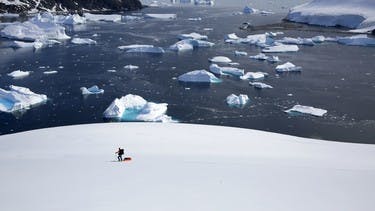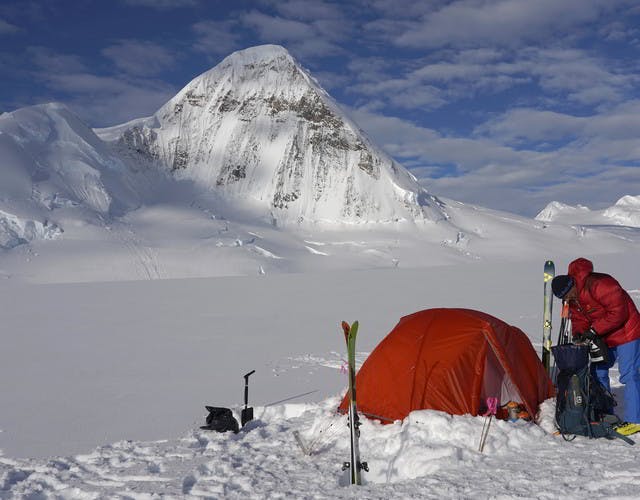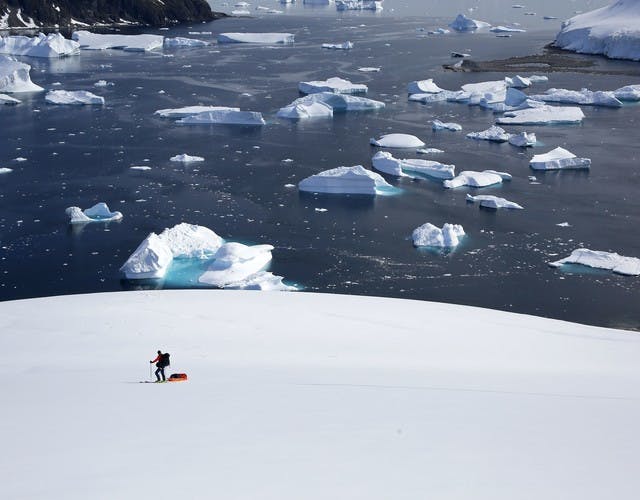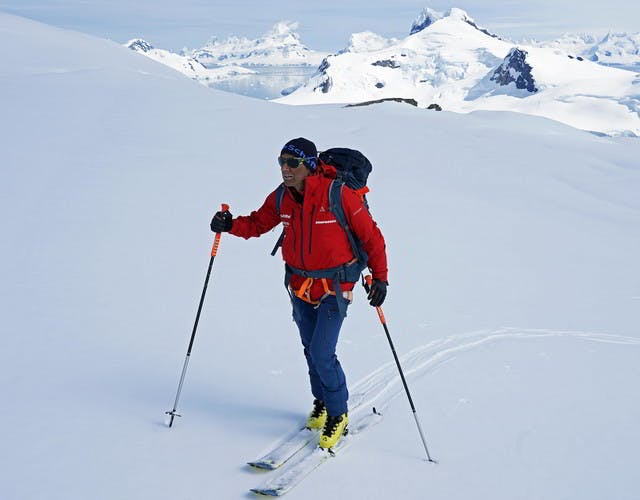
Over a year ago we received an email from our Australian friend and Antarctic specialist Damian Gildea. His approximate words were: "How about a six-week sailing trip to the Antarctic Peninsula? All you have to do is bring a group of explorers and their equipment to the Antarctic Plateau and then pick them up again at the end of their crossing. In addition, you should be available to offer some kind of rescue service in case they need it. In between, the sailing yacht belongs to you! You can do ski tours, first ascents, climb, and see penguins and whales." Within ten minutes Nancy and I replied, "Yes please! We'd love to do that!" As luck would have it, the trip also became our honeymoon. Being crowded together on a 17 metre yacht with eight strangers while crossing one of the wildest waterways on the planet is not everyone's idea of an enjoyable honeymoon. But one thing is certain: Although it was not always romantic, it was certainly unforgettable.

After taking three-and-a-half days to cross the Drake Passage we arrived at the expedition team's starting point in perfect weather. It was a group of six adventurers from all over the world: Australia, Canada, France, Belgium and England. With Nancy, also of Canadian origin, and me from Germany, we really were an international team!
We spent the next seven days moving hundreds of kilograms of equipment and food 35 kilometres and almost 2,000 metres of climbing up to the plateau of the Antarctic peninsula. It was really hard work, but somehow we all made it. After Nancy and I had said goodbye, we spent a day touring on our skis back to the yacht and were ready to start the next part of our adventure.

Our tired legs were happy when Cath, the Australian skipper, suggested we spend a day exploring in the sea kayak. Since Nancy and I had only been canoeing twice before and had actually never sat in a kayak, we started getting a little nervous. But we soon found out that the small boats are quite stable in the water and that it is easy to avoid an early demise in the ice-cold waters of the Antarctic. Paddling between icebergs soaring steeply above us, past calving glaciers, curious penguins and elephant seals dozing in the sun was adventurous and unforgettable.

It was time to look out for climbing and ski tours. First, we sailed south along the spectacular coast of the Antarctic Peninsula to the appropriately named Paradise Bay. The next day we took our Zodiak to a small rock peninsula two kilometres away to climb Mount Hoegh. This is a glacier ski tour with almost 1000 metres of altitude. In beautiful weather in the middle of this fantastic marine glacier landscape, we took twice as long as we should have taken ideally. I'm not sure if we managed to cover 50 metres of altitude in one go without stopping to take photos.

Cath suggested another mountain further south - Mount Demaria. It was one of the most special ski tours Nancy and I have ever done. From the sea to the summit, the almost 1000-metre-high ridge has a steepness of between 30 and 40 degrees - without interruption. The other three sides of the mountain are vertical rock faces. Falling or slipping would be fatal. In spite of the poor visibility, we had perfect avalanche and firn conditions and were able to enjoy a magnificent descent down to the sea.

We received new from our ski expedition group that they would be ready to be picked up in the next few days. No problem - we had plenty of time to sail to their meeting point and help them through the crux of their descent. Three hours after setting off, the yacht's gearbox gave up the ghost and let us get stuck in the increasingly dense drift ice. It wasn't long before we started thinking about Ernest Shackleton's endurance epic. The advantage we had over Shackleton, however, was the tourism that is now emerging in Antarctica:

Hitchhiking #1: The 80-person cruise ship 'Ocean Nova' came to our aid a few hours later and we spent the next ten hours being towed back to the Chilean research station.
Hitchhiking #2: After a few days, the skipper of the yacht 'Ocean Tramp' unexpectedly offered to take Nancy and me to the meeting point to pick up our expedition group. Late in the evening we set up our tent for the night next to a group of fur seals and the next day literally raced towards the expedition group. Due to communication difficulties, the expedition group did not know that we were coming. We met them in a white-out in the middle of their first of two difficult crux sections. If they had not been hauling heavy sledges, the terrain would not have been so dangerous. But with the heavy loads and the lack of experience of half the group, the situation was quite serious. A weight was lifted from our shoulders when we arrived back at the sea with the whole group safe and sound and we could drink to the successful crossing.

Hitchhiking #3: Thanks to the amazing organisational skills of our skipper Cath, we and the tired and exhausted group were generously welcomed on board the Polish yacht 'Selma'. The 'Selma' was already full with 10 divers, crew and equipment, but somehow they managed to accommodate the eight of us, plus our skis, all our equipment and 16 sledges. They fed us very well, brought us back to our yacht and at 3 o'clock in the morning we crashed out in our bunks dead to the world.
Hitchhiking #4: Our next "lift" was with the French Pod Orange. The plan was that they would tow us a few kilometres out into the open sea so that we could set sail on our own to cross back over the Drake Passage. Two-and-a-half days later, they were still towing us. There was no wind. Not a breath!
Hitchhiking #5: Pod Orange had to leave us, otherwise they would be unable to make it to Ushuaia in time. In the middle of the Drake Passage they handed us over to the Russian yacht 'RusArc Aurora', who generously towed us the rest of the way to the Argentine mainland.
Text: Ralf Dujmovits

Ralf Dujmovits lives with his partner Nancy Hansen in the Black Forest and whenever time permits embarks on mountaineering expeditions, tours in the Alps and sport climbing. The professional mountaineer travelled the world for a year between school and medical studies, later he climbed the highest mountains of all seven continents with customers and was the first (and only) German to stand on all 14 peaks above 8000 metres. He became well-known following a 33-hour live broadcast of his ascent of the north face of the Eiger. With over 50 expeditions, he is one of the most experienced mountaineers and mountain guides in the world.






